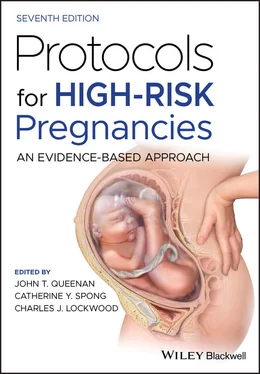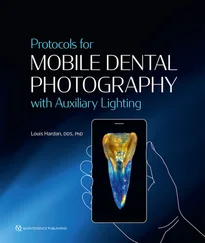Second‐trimester AFP, hCG, uE3, and inhibin‐A
Maternal serum levels of AFP (MSAFP) and unconjugated estriol (uE3) are both approximately 25% lower, and levels of hCG and inhibin‐A approximately twice as high in pregnancies complicated by trisomy 21. MSAFP, uE3, and hCG all tend to be decreased in pregnancies complicated by trisomy 18. The combination of AFP, uE3, hCG and inhibin‐A, commonly known as the quad screen, can detect about 80% of cases of trisomy 21, at a 5% false‐positive rate. Quad marker screening has the additional advantage of also screening for neural tube defects given the inclusion of MSAFP. Performance of serum screening tests is optimized by accurate ascertainment of gestational age, and, wherever possible, sonographic dating should be used instead of menstrual dating.
Combined first‐ and second‐trimester screening
In some programs, multiple markers in both the first and second trimesters are combined to optimize screening performance. The most common approaches include sequential screening, in which first‐trimester combined (serum and NT measurement) screening is performed and results provided. High‐risk patients are offered follow‐up with either cfDNA or diagnostic testing; patients at any risk level can also go on to have quad screening and be provided a final result including all serum analytes as well as the NT. This approach is associated with a 90–95% detection rate for trisomy 21 at a 5% false‐positive rate. It has the advantage of a high detection rate, the provision of a first‐trimester result, and the ability to screen for neural tube defects.
Integrated screening involves the same two‐step screening protocol, but results are not released until all screening steps are completed. This results in a lower false‐positive rate but has the disadvantage of later provision of results. A serum integrated screening approach, including first and second trimester serum analytes, can also be used in patients who do not have access to NT measurement. Again, this has the advantage of a relatively high detection rate but provides a later result.
A wide range of screening tests for fetal aneuploidy, in particular trisomy 21, is now available in both the first and second trimesters. Cell‐free DNA‐based tests are more targeted and precise for the common aneuploidies, so are more appropriate for women at high risk for aneuploidy. Serum‐based tests have higher false‐positive rates but can detect risk for a broader array of abnormalities and therefore have some advantages for women at low risk for aneuploidy. No one approach is best, but concurrent use of serum and cfDNA screening can lead to confusion among patients and providers and should be avoided. All pregnant patients should be provided with pretest counseling to select the most appropriate screening or diagnostic test for their particular circumstances. Rapid developments in the field mean that test options and guidelines are constantly evolving.
1 American College of Obstetricians and Gynecologists. Noninvasive prenatal testing for fetal aneuploidy. Committee Opinion No. 545. Obstet Gynecol 2012; 120:1532–34.
2 American College of Obstetricians and Gynecologists. Practice Bulletin No. 162. Prenatal diagnostic testing for genetic disorders. Obstet Gynecol 2016; 127:e108–22.
3 Bianchi DW, Crombleholme TM, d’Alton ME, Malone FD. Fetology: Diagnosis and Management of the Fetal Patient, 2nd edn. New York: McGraw Hill, 2010.
4 Gil MM, Accurti V, Santacruz B, Plana MN, Nicolaides KH. Analysis of cell‐free DNA in maternal blood in screening for aneuploidies: updated meta‐analysis. Ultrasound Obstet Gynecol 2017; 50(3):302–14.
5 Kaimal AJ, Norton ME, Kuppermann M. Prenatal testing in the genomic age: clinical outcomes, quality of life, and costs. Obstet Gynecol 2015; 126(4):737–46.
6 Malone FD, Canick JA, Ball RH, et al. A comparison of first trimester screening, second trimester screening, and the combination of both for evaluation of risk for Down syndrome. N Engl J Med 2005; 353:2001–11.
7 Norton ME, Jacobsson B, Swamy GK, et al. Cell‐free DNA analysis for noninvasive examination of trisomy. N Engl J Med 2015; 372(17):1589–97.
8 Nyberg DA, Souter VL. Chromosomal abnormalities. In: Nyberg DA, McGahan JP, Pretorius DH, Pilu G (eds) Diagnostic Imaging of Fetal Anomalies. Philadelphia: Lippincott Williams & Wilkins, 2003; pp. 861–906.
9 Palomaki GE, Kloza EM, Lambert‐Messerlian GM, et al. DNA sequencing of maternal plasma to detect Down syndrome: an international clinical validation study. Genet Med 2011; 13:913–20.
10 Salomon LJ, Sotiriadis A, Wulff CB, Odibo A, Akolekar R. Risk of miscarriage following amniocentesis or chorionic villus sampling: systematic review of literature and updated meta‐analysis. Ultrasound Obstet Gynecol 2019; 54(4):442–51.
11 Society for Maternal‐Fetal Medicine (SMFM), Norton ME, Biggio JR, Kuller JA, Blackwell SC. SMFM Consult Series #42: The role of ultrasound in women who undergo cell‐free DNA screening. Am J Obstet Gynecol 2017; 216(3):B2–B7.
PROTOCOL 6 Fetal Echocardiography
Joshua A. Copel
Departments of Obstetrics, Gynecology and Reproductive Sciences, and Pediatrics, Yale School of Medicine, New Haven, CT, USA
Congenital heart disease occurs in approximately eight of 1000 live births. Of these, approximately half are relatively minor ventricular septal defects or valve stenoses that are of little hemodynamic significance. Some of these can be identified prenatally with sensitive color Doppler flow mapping with little clinical impact, while many others are undetectable prenatally. The remainder are significant lesions that may benefit from prenatal detection, parental counseling, and obstetric‐pediatric planning for delivery and neonatal care.
Most types of congenital heart disease are thought to be inherited in multifactorial fashion, with both genetic and environmental contributions. The indications used for fetal echocardiography, a prenatal ultrasound technique that can detect most significant congenital heart disease, reflect that etiological diversity. Many patients referred for fetal echocardiography have had prior affected children or other affected family members, and the recurrence risk for these families is about 2–3% if there has been a prior affected child, and 3–5% if one of the parents has congenital heart disease.
The pathophysiology of congenital cardiac anomalies varies with the type of anatomical abnormality that is present. The underlying mechanisms include failures of cell migration leading to failure of a structure to form, or diminished flow, inhibiting the normal growth of a downstream structure (e.g., poor flow across the foramen ovale and mitral valve predisposing to a coarctation of the aorta).
Structural heart disease
Diagnosis and work‐up
In patients without risk factors for congenital heart disease, full fetal echocardiography, which is generally more time‐consuming and expensive than general obstetric sonography, is not indicated unless cardiac anomalies are suspected. Many risk factors for congenital heart disease have been described ( Table 6.1).
The four‐chamber view of the heart has been suggested as an easy way of screening for congenital heart disease, although its sensitivity to significant cardiac anomalies has varied in the literature. Approximately one‐third of cases of major heart disease are detected on screening prenatal ultrasound, according to a review of the world’s literature. Our own experience suggests that it has a very high positive predictive value, with about half of patients referred for abnormal four‐chamber views actually having cardiac anomalies. Current recommendations from US medical societies, including the American College of Obstetricians and Gynecologists (ACOG), the American Institute of Ultrasound in Medicine (AIUM), and the International Society of Ultrasound in Obstetrics and Gynecology, all call for including outflow tract views in the standard (or so‐called “Level 1”) obstetric scan.
Читать дальше












